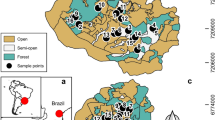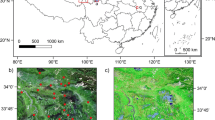Abstract
Pinus sylvestris L., Abies alba Mill. and Fagus sylvatica L.—the significant forest forming tree species in Europe are important for palaeoecological interpretations based on the results of pollen analysis of fossil deposits. The potential pollen loading for Pinus sylvestris, Abies alba and Fagus sylvatica was modelled using simulated and actual vegetation maps, measured fall-speed values and pollen productivity estimates from the literature. The influx of fir pollen drops sharply with distance from the pollen source due to the high fall speed and moderate pollen productivity. The vast majority of Abies alba pollen is deposited within less than 50 m of the sampling site and a major proportion within 100 m. For beech the corresponding numbers would be 300 and 1,800 m, and for pine 1,000 and 4,500 m. The observed mean pollen accumulation rate (PAR) values for Pinus and Fagus were ca. 5,800 and 1,100 grains cm−2 year−1, respectively. In the case of Abies, the mean annual PAR for the whole region is ca. 700 grains cm−2 year−1. In SE Poland the regional signal is represented by PARs of Abies alba <200 grains cm−2 year−1 and of Fagus sylvatica <500 grains cm−2 year−1. The local presence/absence threshold values for Abies alba, Fagus sylvatica and Pinus sylvestris are >1,000 grains cm−2 year−1, >2,000 grains cm−2 year−1 and >3,500 grains cm−2 year−1 respectively.




Similar content being viewed by others
References
Bennett KD, Hicks S (2005) Numerical analysis of surface and fossil pollen spectra from northern Fennoscandia. J Biogeogr 32:407–423
Broström A (2002) Estimating source area of pollen and pollen productivity in the cultural landscapes of southern Sweden—developing a palynological tool for quantifying past plant cover. LUNDQUA thesis 46, Lund University
Broström A, Sugita S, Gaillard M-J (2004) Pollen productivity estimates for reconstruction of past vegetation cover in the cultural landscape of southern Sweden. Holocene 14:371–384
Broström A, Sugita S, Gaillard M-J, Pilesjö P (2005) Estimating spatial scale of pollen dispersal in the cultural landscape of southern Sweden. Holocene 15:1–14
Broström A, Nielsen AB, Gaillard M-J, Hjelle K, Mazier F, Binney H, Bunting J, Fyfe R, Meltsov V, Poska A, Räsänen S, Soepboer W, von Stedingk H, Suutari H, Sugita S (2008) Pollen productivity estimates of key European plant taxa for quantitative reconstruction of past vegetation: a review. Veget Hist Archaeobot 17:461–478
Bunting MJ (2003) Pollen-based reconstruction of cultural landscapes: an investigation of pollen source area for non-arboreal taxa. Rev Palaeobot Palynol 125:285–298
Bunting MJ, Middleton R (2005) Modeling pollen dispersal and deposition using HUMPOL software: simulating wind roses and irregular lakes. Rev Palaeobot Palynol 134:185–196
Bunting MJ, Gaillard M-J, Sugita S, Middleton R, Broström A (2004) Vegetation structure and pollen source area. Holocene 14:651–660
Caseldine C, Fyfe R, Langdon C, Thompson G (2007) Simulating the nature of vegetation communities at the opening of the Neolithic on Achill Island, Co. Mayo, Ireland—the potential role of models of pollen dispersal and deposition. Rev Palaeobot Palynol 144:135–144
Eisenhut G (1961) Untersuchungen über die Morphologie und Ökologie der Pollenkörner heimischer und fremländischer Waldbäume (translated into English by Jackson ST and Jaumann P, 1989). Paul Parey, Hamburg
Gaillard M-J, Birks HJB, Emanuelsson U, Berglund BE (1992) Modern pollen/land-use relationships as an aid in reconstruction of past land-uses and cultural landscapes: example from south Sweden. Veget Hist Archaeobot 1:3–17
Gerasimidis A, Panajotidis S, Hicks S, Athianasiadis N (2006) An eight-year record of pollen deposition in the Pieria mountains (N Greece) and its significance for interpreting fossil pollen assemblages. Rev Palaeobot Palynol 141:231–243
Grądziel T, Janicki G, Furtak T, Pidek IA, Rodzik J (2006) Estimation of the naturality degree and transformation directions of the vegetation based on phytosociological and landscape methods (example from the village of Guciów—Central Roztocze). Regional ecological-landscape studies. Problems of landscape ecology 16, vol I. Polish Association of Landscape Ecology, Warsaw, pp 401–412 (in Polish with English summary)
Harasimiuk M (1994) Geology and relief of the Roztocze National Park. In: Wilgat T (ed) Roztocze National Park. Roztocze National Park, Krakow, pp 55–67 (in Polish)
Hicks S (2001) The use of annual arboreal pollen deposition values for delimiting tree-lines in the landscape and exploring models of pollen dispersal. Rev Palaeobot Palynol 117:1–29
Hicks S, Sunnari A (2005) Adding precision to the spatial factor of vegetation reconstructed from pollen assemblages. Plant Biosyst 139:127–134
Hicks S, Ammann B, Latalowa M, Pardoe H, Tinsley H (1996) European Pollen Monitoring Programme, project description and guidelines. Oulu University Press, Oulu
Hicks S, Tinsley H, Pardoe H, Cundill P (1999) European Pollen Monitoring Programme, supplement to the guidelines. Oulu University Press, Oulu
Hicks S, Tinsley H, Huusko A, Jensen C, Hättestrand M, Gerasimidis A, Kvavadze E (2001) Some comments on spatial variation in arboreal pollen deposition: first records from the Pollen Monitoring Programme (PMP). Rev Palaeobot Palynol 117:183–194
Izdebski K, Czarnecka B, Gradziel T, Lorens B, Popiolek Z (1992) Plant communities against the background of the Roztocze National Park habitat conditions. Maria Curie-Sklodowska University Press, Lublin (in Polish with English summary)
Jensen C, Vorren K-D, Mørkved B (2007) Annual pollen accumulation rate (PAR) at the boreal and alpine forest-line of north-western Norway, with special emphasis on Pinus sylvestris and Betula pubescens. Rev Palaeobot Palynol 144:337–361
Kaszewski BM, Czerniawski M, Mucha B (2002) Climate conditions of Roztocze. In: Buraczyński J (ed) Roztocze—natural environment. Lubelskie Press, Lublin, pp 208–220 (in Polish)
Latałowa M, Ralska-Jasiewiczowa M, Miotk-Szpiganowicz G, Zachowicz J, Nalepka D (2004) Fagus sylvatica L.—Beech. In: Ralska-Jasiewiczowa M, Latałowa M, Wasylikowa K, Tobolski K, Madeyska E, Wright HE Jr, Turner C (eds) Late Glacial and Holocene history of vegetation in Poland based on isopollen maps. W. Szafer Institute of Botany, Polish Academy of Sciences, Kraków, pp 95–104
Maher LJ Jr (1981) Statistics for microfossil concentration measurements employing samples spiked with marker grains. Rev Palaeobot Palynol 32:153–191
Middleton R, Bunting MJ (2004) Mosaic v 1.1: landscape scenario creation software for simulation of pollen dispersal and deposition. Rev Palaeobot Palynol 132:61–66
Nielsen AB (2003) Pollen based quantitative estimation of land cover—relationships between pollen sedimentation in lakes and land cover as seen on historical maps in Denmark AD 1800. PhD thesis, University of Copenhagen, and Geological Survey of Denmark and Greenland. Danmarks og Grønlands geologiske undersøgelse rapport 2003/57
Obidowicz A, Szczepanek K, Madeyska E, Nalepka D (2004) Abies alba Mill.—Fir. In: Ralska-Jasiewiczowa M, Latałowa M, Wasylikowa K, Tobolski K, Madeyska E, Wright HE Jr, Turner C (eds) Late Glacial and Holocene history of vegetation in Poland based on isopollen maps. W. Szafer Institute of Botany, Polish Academy of Sciences, Kraków, pp 31–38
Odgaard BV, Rasmussen P (2000) Origin and temporal development of macro-scale vegetation patterns in the cultural landscape of Denmark. J Ecol 88:733–748
Poska A, Sepp E, Veski S, Koppel K (2008) Using quantitative pollen-based land-cover estimations and a spatial CA_Markov model to reconstruct the development of cultural landscape at Röuge, South Estonia. Veget Hist Archaeobot 17:527–541
Prentice IC (1985) Pollen representation, source area, and basin size: towards a unified theory of pollen analysis. Quat Res 23:76–86
Räsänen S (2006) Palynological tools for quantitative reconstructions of human impact on vegetation in Fennoscandian boreal forests. PhD thesis, Nordia, Geographical Publications 35:1
Rodkiewicz B (1984) Embryology of coniferous plants. PWN, Warsaw (in Polish)
Seppä H, Hicks S (2006) Integration of modern and past pollen accumulation rate (PAR) records across the arctic tree-line: a method for more precise vegetation reconstructions. Quat Sci Rev 25:1501–1516
Sjögren P, van der Knaap WO, Huusko A, van Leeuwen JFN (2008) Pollen productivity, dispersal, and correction factors for major tree taxa in the Swiss Alps based on pollen-trap results. Rev Palaeobot Palynol 152:200–210
Spieksma FThM, Corden JM, Detandt M, Millington WM, Nikkels H, Nolard N, Schoemakers CHH, Wachter R, de Weger LA, Willems R, Emberlin J (2003) Quantitative trends in annual totals of five common airborne pollen types (Betula, Quercus, Poaceae, Urtica and Artemisia), at five pollen-monitoring stations in western Europe. Aerobiologia 19:171–184
Stockmarr J (1971) Tablets with spores used in absolute pollen analysis. Pollen Spores 13:615–621
Sugita S (1994) Pollen representation of vegetation in Quaternary sediments: theory and method in patchy vegetation. J Ecol 82:881–897
Sugita S, Gaillard M-J, Broström A (1999) Landscape openness and pollen records: a simulation approach. Holocene 9:409–421
Tauber H (1965) Differential pollen dispersion and the interpretation of pollen diagrams. Dan Geol Unders 2 rk 89:1–69
Tonkov S, Hicks S, Bozilova E, Atanassova J (2001) Pollen monitoring in the central Rila Mountains, Southwestern Bulgaria: comparisons between pollen traps and surface samples for the period 1993–1999. Rev Palaeobot Palynol 117:167–182
Warakomski W (1994) Outline of the Roztocze climate. In: Wilgat T (ed) Roztocze National Park. Roztocze National Park, Cracow, p 42 (in Polish)
Wilgat T (1990) The Roztocze National Park. The Roztocze National Park Press, Zwierzyniec
Acknowledgements
The authors are especially grateful to Prof. Sheila Hicks, Prof. Marie-Jose Gaillard, Prof. Shinya Sugita, Dr. Jane Bunting and Dick Middleton for inspiring discussions and user-friendly software development. We are also thankful to anonymous referees for comments and suggestions, and to Drs. Heather Pardoe and R. Szava-Kovats for linguistic revision. The work was made possible by an agreement of cooperation between the Polish and Estonian Academies of Sciences. Financial support was provided by project no. N304 092 32/3590 by the Polish Ministry of Science and Higher Education (years 2007–2010), Estonian target funding projects SF0180048s08 and SF0332710s06, and ETF grant no. 6995.
Author information
Authors and Affiliations
Corresponding author
Additional information
Communicated by M. Latalowa.
This paper is a contribution to the Pollen Monitoring Programme (PMP) and POLlen–LANDscape CALibration (POLLANDCAL) networks.
Rights and permissions
About this article
Cite this article
Poska, A., Pidek, I.A. Pollen dispersal and deposition characteristics of Abies alba, Fagus sylvatica and Pinus sylvestris, Roztocze region (SE Poland). Veget Hist Archaeobot 19, 91–101 (2010). https://doi.org/10.1007/s00334-009-0230-x
Received:
Accepted:
Published:
Issue Date:
DOI: https://doi.org/10.1007/s00334-009-0230-x




